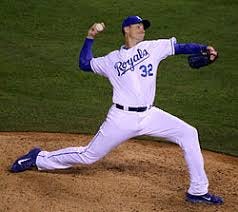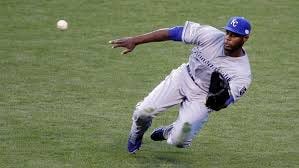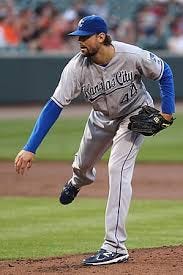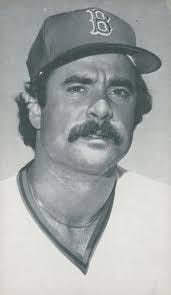May 1, 2015—Tigers
Edinson Volquez is suspended for his part in the Chicago “brawl” (imagine the punishment if he actually managed to hit somebody—anger management classes or boxing lessons seem more appropriate) and the Royals need a pitcher to fill in, so Chris Young gets his first start as a Royal.
Young throws five no-hit innings against the Detroit Tigers and does it with a fastball that tops out at 88 MPH, a slider and a few changeups.
Afterwards, people try to explain why Chris is so hard to hit. The most popular theory has to do with Young’s height—6 feet 10 inches; being that tall must give an unusual angle to his pitches and also means he’s closer to home plate when he lets go of that 88-MPH heater.
Here’s another theory: Chris Young hits the mitt.
If a pitcher doesn’t know exactly where the ball is going, his defense has to play straight up; the pitcher might aim for the outside corner, but hit the inside corner. That means his defense has to be able to go left or right because they don’t know whether the ball will be hit to the opposite field or pulled.
When a pitcher hits the mitt, the defense can shift with more confidence and overload the parts of the field where a ball’s most likely to be put in play. A pitcher like Chris Young gets better defense than a pitcher with less control.
We fixate on velocity because it’s easy to measure, but Chris Young demonstrates location and movement are just as important.
And as long as we’re talking about defense:
Fans and the media think diving catches are great defense, but when a coach sees a diving catch he sees a poorly-executed pitch or a defender positioned in the wrong spot. To coaches, routine plays—we made the right pitch and had a guy in the right spot—are great defense that the rest of us don’t appreciate.
In the eighth inning Kelvin Herrera has one down, the bases loaded, a 4-1 lead and the best hitter on the planet—Miguel Cabrera—at the plate. Herrera goes after Cabrera and strikes him out in a 10-pitch at-bat which has everyone holding their breath.
But with the bases loaded, what other choice did Herrera have?
Well…
In a different game, when Wade Davis had a three-run lead, the bases loaded and Miguel Cabrera at the plate, Wade walked him. After the game I asked Wade if he’d walked Cabrera with the bases loaded on purpose.
Wade smiled and said: “One run’s better than four.”
After hanging around major league pitchers I realize they intentionally walk batters way more often than we realize, so the total number of walks doesn’t tell the whole story; you need to know who they walked and when they walked them.
Rusty Kuntz—2013
Rusty’s in charge of outfield positioning, so I ask him if he ever moves an outfielder just to wake the guy up; Rusty laughs, names an ex-Royal player and says he had to move him all the time.
Rusty would move him in a few steps on one pitch, left a few steps on another, to the right on the next pitch and back on the pitch after that. After four pitches the guy would be right back where he started.
I then ask if outfielders ever come in to the dugout after being moved around in a circle and ask Rusty just what the fuck he’s doing.
Rusty says: “The smart ones do—the dumb ones think it’s good coaching.”
So how does Rusty know when a guy needs to be moved?
“His feet.”
Rusty tells me that when an outfielder’s stance starts to widen, he’s falling asleep. His hands will go from his hips to his knees and he’ll plant himself in one place. If a hitter fouls a ball off and the outfielder’s feet don’t move—if he just turns his head and watches—Rusty knows it’s time to get the outfielder moving.
And that actually is good coaching.
Rusty Kuntz—2015
A fan is talking to Rusty and the fan says he has a bunch of Rusty’s old baseball cards. Rusty asks the fan if he could tell which card was Rusty’s favorite. The fan has no idea and Rusty says it’s the card from 1981.
Now Rusty wants to know if the fan can guess why that card is his favorite.
Once again the fan can’t answer the question and Rusty says it’s because that was one of the few years he played enough to have an action shot on his card. Most years Rusty’s card shows him in a batting cage or looking pensive leaning against a dugout railing. I’ve looked up Rusty’s cards and he isn’t lying.
I don’t know if they make cards for baseball coaches, but if they don’t they need to start.
May 5, 2015—Indians
The Royals are playing the Indians and before the bottom of the fourth inning, Cleveland catcher Roberto Perez bounces his throw down to second base. The Indians throw the ball around the infield and shortstop Mike Aviles and third baseman Lonnie Chisenhall check the ball. Chisenhall decides the ball is scuffed, holds it up and shakes it; which is the sign for a new ball—and a sign that the Indians might want to work on their cheating.
If a ball is accidentally scuffed and you’re on defense, why give it back to the umpire?
And why let an infielder make that decision?
If none of the umpires see the throw bounce, give that scuffed baseball to your pitcher. If the pitcher doesn’t know how to use a scuffed baseball, tell him to go down to the bullpen and practice.
Veteran catchers will sometimes bounce the in-between innings throw to second base on purpose; that gives their pitcher a scuffed baseball. When some naïve rookie gives the ball back to the umpire because it’s scuffed, those veteran catchers get pissed.
The Indians are either being extremely honest or extremely dumb and now that I think about it there’s no reason they can’t be both.
May 7, 2015—Indians
In the sixth inning of a 7-4 win over the Indians, Luke Hochevar steps on a Big League pitching mound for the first time in 585 days. That number comes from Star beat reporter Andy McCullough and I trust Andy because he wears those horn-rim glasses that automatically make you better at math.
Plus, 585 days sounds about right.
Those of us who have been around the team for those 585 days have been watching Luke rehab for a very very long time. When you see a guy work extremely hard to overcome an obstacle and then succeed, you might feel like showing some appreciation—but there’s no cheering in the press box.
On the other hand, I’m not in the press box right now—so good for you, Luke.
Luke Hochevar—2007
When Luke Hochevar makes his major league debut, the Royals bullpen coach is Fred Kendall; Jason Kendall’s dad. As Luke leaves the bullpen to pitch in his first Big League game, Fred says: “Hey, kid, do me a favor—don’t look up.”
Luke runs to the mound thinking: “Don’t look up? Don’t look up? What the hell does that mean?”
Luke reaches the infield, walks up the back side of the mound and makes a mistake: he looks up. When he sees the size of the crowd and the stadium he thinks: “Oh, shit!” Luke would have been better off focusing on the catcher’s mitt and not the crowd. Even though he didn’t follow Fred Kendall’s advice, Luke gets over his nerves and pitches three scoreless innings.
May 7, 2015—Indians
The game is delayed two hours and 17 minutes and a lengthy rain delay is hard on the media; we’re bored so we eat. Baseball teams throw food at reporters like we’re being fattened up for the county fair.
Generally speaking, the media is obsessed with food.
A reporter who has absolutely no idea what the starting pitchers ERAs are or how they threw in their last outing can tell you what’s on the menu for that night.
After the media requests ice cream—because we clearly aren’t consuming enough calories—the Royals come through and now we can make an ice cream Sundae any time we like, assuming the other reporters haven’t scraped the ice cream carton clean.
Originally, we had a soft-serve ice cream machine, but according to an informative kitchen worker, demand was so heavy we broke it in the first hour. Now we have to scoop the ice cream by hand and apparently some media members have complained that scooping ice cream by hand is just too much work.
When I tell this story to Jason Kendall and Mike Sweeney, they laugh their asses off. Jason demands that I tell the story again to clubhouse manager Jeff Davenport and they laugh their asses off.
Again.
To be fair, I’m as bad as anyone else; I’ve probably put on 10 pounds since becoming a baseball writer, but I am willing to scoop my own ice cream.
It’s good for your upper body strength.
May 8, 2015—Tigers
In the second inning of a loss to the Tigers, Ian Kinsler singles and Andrew Romine scores from second base. The throw from right fielder Paulo Orlando beats Romine to home plate—the ball is in Salvador Perez’ mitt when Romine is still a good 10-15 feet away from scoring—but Sal’s set up too far out in front of home plate.
After Buster Posey got hurt on a play at the plate, baseball freaked out about star players getting injured and as the above picture demonstrates, now it’s rare to see a catcher block the plate. Instead they set up in front of the plate, try to catch the ball, then turn and make the tag and the toughest play is a throw from right field because the catcher is turned away from the runner and has a long tag to make.
This less exciting version of baseball is about money; stars sell tickets and they can’t sell tickets if they get hurt and can’t play.
The Detroit announcers think Romine will be thrown out, but because Perez is a positioned a foot or two in front of the plate, Romine is safe. The TV guys talk about Romine’s great slide; not where Perez set up. Salvador Perez avoids a collision, but makes it easier for Andrew Romine to score.
The Royals lose by one run.
The Onion of Knowledge
It’s my sixth season covering Big League baseball and by this point most of the players and coaches are comfortable talking to me and explaining what they do and why they do it and being a cartoonist in my less-interesting job, I’m big on metaphors and come to think of baseball as an onion:
Peel back a layer and there’s another one underneath…
And another one under that…
And another one under that...
Longtime players and coaches say you (and they) will never totally understand baseball; there’s always something else to learn so every once in a while, maybe you should shut the fuck up and listen.
Their humble approach to baseball stands in contrast to all the sports-talk radio hosts, newspaper columnists, analytics advocates and people who get on social media and leave negative comments. Without playing a single inning of Big League baseball all these critics talk as if they already know everything and when you think you already know everything you can’t learn anything.
Next Up: Royals fans find something to bitch about.












Miggy Cabrera seemed to smack Royals pitchers around like he was just toying with them.
Amen re: Uncle Rusty on a baseball card. I would frame that sucker, maybe build an alter.
Didn't realize Jason Kendall had a father. I've always assumed he just beamed himself to earth from Planet Badass.
Probably my warmest, squishy memory from 2015 is Luke Hochevar coming out of bullpen and at last achieving success after all his troubles. Also loved the way he looked down just before delivering a pitch. Always wondered why. Thanks for providing the answer.
Please keep peeling that onion, Mr. J. These posts are priceless to a baseball addict like myself.